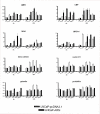Androgen regulation of the androgen receptor coregulators
- PMID: 18673534
- PMCID: PMC2518564
- DOI: 10.1186/1471-2407-8-219
Androgen regulation of the androgen receptor coregulators
Abstract
Background: The critical role of the androgen receptor (AR) in the development of prostate cancer is well recognized. The transcriptional activity of AR is partly regulated by coregulatory proteins. It has been suggested that these coregulators could also be important in the progression of prostate cancer. The aim of this study was to identify coregulators whose expression is regulated by either the androgens and/or by the expression level of AR.
Methods: We used empty vector and AR cDNA-transfected LNCaP cells (LNCaP-pcDNA3.1, and LNCaP-ARhi, respectively), and grew them for 4 and 24 hours in the presence of dihydrotestosterone (DHT) at various concentrations. The expression of 25 AR coregulators (SRC1, TIF2, PIAS1, PIASx, ARIP4, BRCA1, beta-catenin, AIB3, AIB1, CBP, STAT1, NCoR1, AES, cyclin D1, p300, ARA24, LSD1, BAG1L, gelsolin, prohibitin, JMJD2C, JMJD1A, MAK, PAK6 and MAGE11) was then measured by using real-time quantitative RT-PCR (Q-RT-PCR).
Results: Five of the coregulators (AIB1, CBP, MAK, BRCA1 and beta-catenin) showed more than 2-fold induction and 5 others (cyclin D1, gelsolin, prohibitin, JMJD1A, and JMJD2C) less than 2-fold induction. Overexpression of AR did not affect the expression of the coregulators alone. However, overexpression of AR enhanced the DHT-stimulated expression of MAK, BRCA1, AIB1 and CBP and reduced the level of expression of beta-catenin, cyclinD1 and gelsolin.
Conclusion: In conclusion, we identified 5 coactivators whose expression was induced by androgens suggesting that they could potentiate AR signaling. Overexpression of AR seems to sensitize cells for low levels of androgens.
Figures




Similar articles
-
Expression of androgen receptor coregulators in prostate cancer.Clin Cancer Res. 2004 Feb 1;10(3):1032-40. doi: 10.1158/1078-0432.ccr-0990-3. Clin Cancer Res. 2004. PMID: 14871982
-
Increased expression of androgen receptor sensitizes prostate cancer cells to low levels of androgens.Cancer Res. 2009 Oct 15;69(20):8141-9. doi: 10.1158/0008-5472.CAN-09-0919. Epub 2009 Oct 6. Cancer Res. 2009. PMID: 19808968
-
Cell-line and tissue-specific signatures of androgen receptor-coregulator transcription.J Mol Med (Berl). 2006 Nov;84(11):919-31. doi: 10.1007/s00109-006-0081-1. Epub 2006 Aug 24. J Mol Med (Berl). 2006. PMID: 16932916
-
Functional analysis of androgen receptor N-terminal and ligand binding domain interacting coregulators in prostate cancer.J Formos Med Assoc. 2000 Dec;99(12):885-94. J Formos Med Assoc. 2000. PMID: 11155740 Review.
-
Identification and characterization of androgen receptor associated coregulators in prostate cancer cells.J Biol Regul Homeost Agents. 2001 Apr-Jun;15(2):123-9. J Biol Regul Homeost Agents. 2001. PMID: 11501969 Review.
Cited by
-
KDM1 class flavin-dependent protein lysine demethylases.Biopolymers. 2015 Jul;104(4):213-46. doi: 10.1002/bip.22643. Biopolymers. 2015. PMID: 25787087 Free PMC article. Review.
-
Nuclear receptor coactivators: structural and functional biochemistry.Biochemistry. 2011 Jan 25;50(3):313-28. doi: 10.1021/bi101762x. Epub 2010 Dec 29. Biochemistry. 2011. PMID: 21141906 Free PMC article. Review.
-
New transcriptional-based insights into the pathogenesis of desmoplastic small round cell tumors (DSRCTs).Oncotarget. 2017 May 16;8(20):32492-32504. doi: 10.18632/oncotarget.16477. Oncotarget. 2017. PMID: 28415643 Free PMC article.
-
Androgen Receptor regulation of Vitamin D receptor in response of castration-resistant prostate cancer cells to 1α-Hydroxyvitamin D5 - a calcitriol analog.Genes Cancer. 2010 Nov 16;1(9):927-940. doi: 10.1177/1947601910385450. Genes Cancer. 2010. PMID: 21552398 Free PMC article.
-
Cancer biomarker discovery: the entropic hallmark.PLoS One. 2010 Aug 18;5(8):e12262. doi: 10.1371/journal.pone.0012262. PLoS One. 2010. PMID: 20805891 Free PMC article.
References
-
- Cooperberg MR, Moul JW, Carroll PR. The changing face of prostate cancer. J Clin Oncol. 2005;23:8146–8151. - PubMed
-
- Boyle P, Ferlay J. Cancer incidence and mortality in Europe, 2004. Ann Oncol. 2005;16:481–488. - PubMed
-
- Isaacs JT. Role of androgens in prostatic cancer. Vitam Horm. 1994;49:433–502. - PubMed
-
- Thompson IM, Goodman PJ, Tangen CM, Lucia MS, Miller GJ, Ford LG, Lieber MM, Cespedes RD, Atkins JN, Lippman SM, Carlin SM, Ryan A, Szczepanek CM, Crowley JJ, Coltman CA., Jr The influence of finasteride on the development of prostate cancer. N Engl J Med. 2003;349:215–224. - PubMed
-
- Huggins C, Hodges CV. Studies on prostatic cancer, I: the effect of castration, of estrogen and of androgen injection on serum phosphatases in metastatic carcinoma of the prostate 1941. J Urol. 2002;168:9–12. - PubMed
Publication types
MeSH terms
Substances
LinkOut - more resources
Full Text Sources
Medical
Molecular Biology Databases
Research Materials
Miscellaneous

